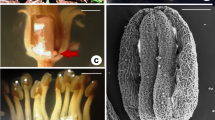Abstract
Plant species that secrete oil as their primary floral reward are rare and sporadically found in the angiosperms. We report here thatMonttea, a genus previously unsuspected of being an oil-plant, produces lipids from trichome elaiophores on the inside of the lower (anterior) lip. The discovery of the production of oils by species of this S. American genus explains the occurrence of unusual dual-function collecting structures in ArgentineCentris (Hymenoptera: Anthophoridae) and explains the presence of oil-collecting bees in regions where oil-secreting flowers were previously thought to be absent. The behavior of these centridine pollinators onMonttea flowers parallels that of oil-collecting bees onDiascia (Scrophulariaceae) in S. Africa.
Similar content being viewed by others
References
Argue, C. L., 1985: Pollen morphology in the generaMonttea andMelosperma (Scrophulariaceae). — Amer. J. Bot.72: 1248–1255.
Barringer, K., 1981: A revision ofAngelonia (Scrophulariaceae). — Ph.D. Dissertation submitted to the University of Connecticut, Storrs. — Storrs, CT.
—, 1983:Monopera, a new genus ofScrophulariaceae from South America. — Brittonia35: 111–114.
—, 1985: Revision of the genusBasistemon (Scrophulariaceae). — Syst. Bot.10: 125–133.
Bentham, G., Hooker, J. D., 1876: Ordo 115.Scrophulariaceae. — InBentham, G., Hooker, J. D., (Eds.): Genera Plantarum 2, pp. 913–980. — London.
Buchmann, S. L., 1987: The ecology of oil flowers and their bees. — Annu. Rev. Ecol. Syst.18: 343–368.
Bureau, E., 1863: Étude sur les genresReyesia etMonttea, et observations sur la tribu des Platycarpées deM. Miers. — Bull. Soc. Bot. France10: 35–47.
Gay, C., 1849: Historia Fisica y Politica de Chile. II. 4, Botanica. — Santiago: Museo de Historia Natural de Santiago.
Harder, L. D., Thomason, J. D., 1989: Evolutionary options for maximizing pollen dispersal of animal-pollinated plants. — Amer. Nat.133: 323–344.
Jensen-Haarup, A. C., 1908: Biological researches amongst the Argentine bees with special reference to flowers they visit. — Flora og Fauna 1908: 95–107.
Mabberley, D. J., 1987: The plant book. — Cambridge, U.K.: Cambridge University Press.
Michener, C. D., 1981: Classification of the bee familyMelittidae with a review of species ofMeganomiinae. — Contr. Amer. Entomol. Inst.18: 1–135.
Molau, U., 1988:Scrophulariaceae 1.Calceolarieae. — Flora Neotropica47: 1–326.
Neff, J. L., Simpson, B. B., 1981: Oil-collecting structures in theAnthophoridae (Hymenoptera): Morphology, function, and use in systematics. — J. Kansas Entomol. Soc.54: 95–123.
Pennell, F. W., 1920:Scrophulariaceae of Colombia. 1. — Proc. Acad. Natl. Sci. Philadelphia72: 136–188.
—, 1935:Scrophulariaceae of eastern temperate North America. — Monogr. Acad. Nat. Sci. Philadelphia1: 1–650.
Raman, S., 1987: The trichomes on the corolla of theScrophulariaceae. 2: tribesHemimerideae andCalceolarieae. — Beitr. Biol. Pflanzen64: 141–155.
Renner, S. S., 1989: A survey of reproductive biology in neotropicalMelastomataceae andMemecylaceae. — Ann. Missouri Bot. Gard.76: 496–518.
Rossow, R. A., 1985:Melospermeae, nueva tribu deScrophulariaceae. — Parodiana3: 365–396.
Simpson, B. B., 1975: Pleistocene changes in the flora of the high tropical Andes. — Paleobiology1: 275–294.
—, 1989: Pollination biology and taxonomy ofDinemandra andDinemagonum (Malpighiaceae). — Syst. Bot.14: 408–426.
—,Neff, J. L., 1981: Floral rewards: alternatives to pollen and nectar. — Ann. Missouri Bot. Gard.68: 301–322.
—, —, 1983: Evolution and diversity of floral rewards. — InJones, C. E., Little, R. J., (Eds.): Handbook of experimental pollination biology, pp 142–159. — New York: van Nostrand Reinhold.
Snelling, R. R., 1984: Studies on the taxonomy and distribution of American centridine bees (Hymenoptera: Anthophoridae). — Contr. in Science, L. A. County Mus. Nat. Hist.347: 1–69.
Spencer-Both, Y., 1965: The collection of pollen by bumblebees and its transport in the corbiculae and the proboscidial fossa. — J. Apic. Res.4: 185–190.
Stahl, E., 1969: Thin-layer chromatography. A laboratory handbook. 2. Translated byM. R. F. Ashworth. — New York: Springer.
Steiner, K. E., 1985: The role of nectar and oil in the pollination ofDrymonia serrulata (Gesneriaceae) byEpicharis bees (Anthophoridae) in Panama. — Biotropica17: 217–229.
—, 1989: A second species of the amphi-Atlantic genusAlonsoa (Scrophulariaceae) in South Africa. — Ann. Missouri Bot. Gard.76: 1152–1159.
—,Whitehead, V. B., 1988: The association between oil-producing flowers and oil-collecting bees in the Drakensberg of southern Africa. — Monogr. Syst. Bot. Missouri Bot. Gard.25: 259–277.
Thieret, J., 1967: Subspecific classification in theScrophulariaceae: a review. — Sida3: 87–106.
Vogel, S., 1974: Ölblumen und ölsammelnde Bienen. — Akad. Wiss. Abh. Math.-Naturwiss. Kl.7: 1–267.
—, 1988: Die Ölblumensymbiosen — Parallelismus und andere Aspekte ihrer Entwicklung in Raum und Zeit. — Z. Zool. Syst. Evolut.-Forsch.26: 341–362.
—,Michener, C. D., 1985: Long bee legs and oil-producing floral spurs, and a newRediviva (Hymenoptera, Melittidae;Scrophulariaceae). — J. Kansas Entomol. Soc.58: 359–364.
Wettstein, R. von, 1891:Scrophulariaceae. — InEngler, A., Prantl, K., (Eds.): Die natürlichen Pflanzenfamilien. IV. 3b, pp. 39–107. — Leipzig: Engelmann.
Author information
Authors and Affiliations
Rights and permissions
About this article
Cite this article
Simpson, B.B., Neff, J.L. & Dieringer, G. The production of floral oils byMonttea (Scrophulariaceae) and the function of tarsal pads inCentris bees. Pl Syst Evol 173, 209–222 (1990). https://doi.org/10.1007/BF00940864
Received:
Accepted:
Issue Date:
DOI: https://doi.org/10.1007/BF00940864




